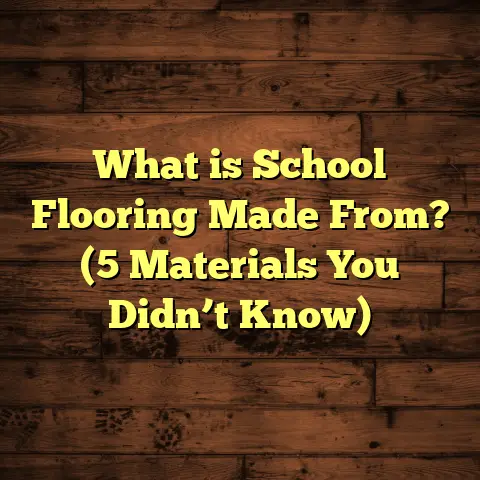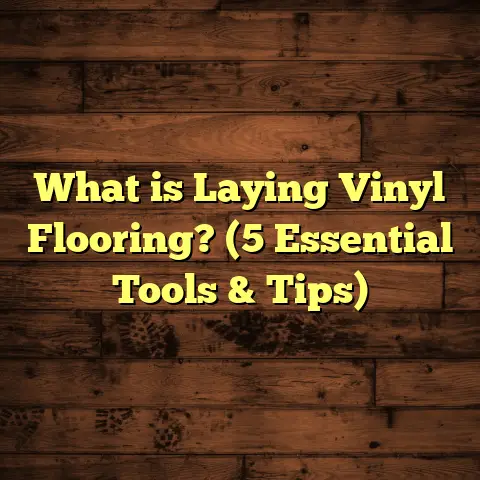What Is a Floor Burnisher? (5 Key Benefits for Clean Floors)
I have a confession: I once thought a floor burnisher was some kind of fancy dance move. You know, like the “floor burnisher shuffle” or the “buff and shine two-step.” Turns out, it’s way cooler — and a lot less embarrassing at parties. If you’ve ever wondered about those shining floors in malls, hospitals, or even your local gym, there’s a good chance a floor burnisher was behind that gleam.
I remember the first time I saw a floor burnisher in action. It was at a large office building where I was called in to help with floor maintenance. The janitor was using this big machine that looked like a vacuum cleaner on steroids. As the machine hummed along, the floor transformed from dull and scuffed to smooth and glossy in minutes. I was hooked.
What Is a Floor Burnisher?
Simply put, a floor burnisher is a machine designed to make hard floors look shiny and polished. Think of it as a giant, powered shoe polisher for your floors. It uses a high-speed rotating pad or brush to buff the surface, removing scuffs, scratches, and dirt while giving the floor a mirror-like shine.
If you’ve ever tried to polish your floors by hand and ended up with sore arms and uneven patches, you know why this machine is a game-changer. Burnishers operate at speeds often between 1,200 and 3,000 revolutions per minute (RPM), which is way faster than your average household buffer.
The high speed generates frictional heat that smooths and compresses the finish layer on floors — whether that’s wax, polyurethane, or another protective coating. This process rejuvenates the finish without stripping it away like traditional stripping methods might.
Types of Floor Burnishers
There are several types of floor burnishers suited for different tasks:
- Electric Burnishers: The most common type for commercial and residential use. These plug into an outlet and come in various sizes and power levels.
- Battery-Powered Burnishers: Portable and cordless; great for smaller areas or places without easy access to power. Limited runtime can be a downside.
- Propane Burnishers: Used mainly in industrial settings for large areas; they provide powerful performance but require proper ventilation.
- Cordless Lithium-Ion Models: Newer on the market with longer battery life and quieter operation.
Each has its pros and cons depending on your floor type, size of the area, and budget.
What Floors Can You Burnish?
Hard surfaces like vinyl, marble, terrazzo, hardwood (sealed), and concrete respond best to burnishing. It’s not for carpets or soft surfaces. In my experience, vinyl composition tile (VCT) floors really benefit from regular burnishing to keep them looking fresh without waxing every week.
Burnishing is particularly popular for commercial spaces where foot traffic is heavy and floors need continuous upkeep without downtime for waxing or refinishing.
How Does a Floor Burnisher Work?
At its core, the burnisher’s motor spins a pad or brush at high speed. This friction generates heat and smooths out surface imperfections. The pads used can vary in abrasiveness depending on the floor type and desired finish.
Usually, you start by cleaning the floor to remove loose dirt. Then, you attach the correct pad to the burnisher and gently glide it over the floor in overlapping passes. The result? A glossy, smooth surface that practically reflects your coffee cup.
The pads themselves are made from materials like synthetic fibers or natural abrasives. They come in various grades — from coarse for heavy-duty cleaning and stripping to ultra-fine for polishing and finishing.
The heat generated by burnishing slightly melts the wax or finish on the floor’s surface, allowing it to bond better and appear smoother. This process also compresses tiny scratches that otherwise scatter light unevenly and dull the appearance.
Installation and Setup: What You Need to Know
Unlike some flooring equipment that requires professional setup, floor burnishers are pretty straightforward. Most models come pre-assembled or with simple assembly instructions.
Here’s what I always recommend before using one:
- Check the power source: Most burnishers run on standard 110V outlets but confirm your model’s requirements.
- Select the right pad: Using the wrong pad can dull your floors or even damage them.
- Test in a small area: Before tackling the whole room, try a patch to see how your floor reacts.
- Wear proper PPE: Safety goggles and ear protection are smart choices; these machines can be loud.
- Clear the area: Remove obstacles and cords that could cause tripping or damage.
- Inspect the machine: Make sure all parts are secure and the pad is properly attached.
Once everything is set up, it’s just a matter of turning it on and moving steadily over the surface. Keep the burnisher moving — don’t let it stay in one spot too long or you risk overheating or damaging the finish.
Maintenance Tips to Keep Your Burnisher Running Smoothly
I once had a client who neglected their burnisher maintenance — let’s just say it sounded like a lawnmower on steroids after a couple of months.
To avoid that embarrassment:
- Clean the pads after each use: Dirty pads spread grime instead of polishing.
- Inspect the power cord: Frayed cords are dangerous and can cause machine failure.
- Lubricate moving parts: Check your manual for guidance on oiling bearings or joints.
- Store it properly: Keep your burnisher in a dry, cool place to prevent rust and motor damage.
- Check brushes (if applicable): Some models have motor brushes that wear out over time.
- Replace worn pads regularly: Worn pads lose effectiveness and can scratch floors.
Regular maintenance extends the life of your machine and guarantees consistent performance.
5 Key Benefits of Using a Floor Burnisher for Clean Floors
1. Brilliant Shine That Lasts
If you want floors that look professionally maintained without constant waxing, burnishing is the answer. The high-speed action polishes the finish, restoring luster that lasts for weeks. According to industry data, floors burnished weekly maintain gloss levels 30% higher than those only mopped or waxed.
This shine isn’t just about looks; it also signals cleanliness which boosts customer impressions in retail spaces or comfort in homes.
2. Saves Time and Labor Costs
Manually polishing floors is back-breaking work. Using a burnisher reduces the time needed by up to 50%, freeing you to focus on other tasks. I remember a commercial client who cut their floor maintenance hours from 20 per week to just 8 after switching to burnishing.
That’s not just about faster cleaning — it also means less money spent paying staff or contracting outside help.
3. Extends Floor Life
Consistent burnishing prevents surface wear by smoothing out scratches and compressing the finish layer. Research shows that floors maintained with regular burnishing last up to 40% longer before needing replacement or refinishing.
Imagine how often you could avoid costly renovations just by keeping up with proper maintenance!
4. Improves Safety by Reducing Slipperiness Issues
A well-burnished floor has better traction than heavily waxed or dirty surfaces. Burnishing removes wax buildup that can become slippery over time, reducing slip-and-fall hazards in busy areas like hospitals or schools.
Safety is often overlooked when thinking about floor care but it’s critical — especially where liability is concerned.
5. Cost-Effective Maintenance Solution
When you factor in labor savings, longer floor life, and reduced need for costly waxing chemicals, investing in a floor burnisher has an excellent return on investment (ROI). For example, one study found that facilities using burnishers saved an average of $3,500 annually on maintenance costs per 10,000 square feet.
Plus, fewer chemical applications mean fewer fumes and less environmental impact — something I’m always glad to see clients appreciate.
My Personal Experience With Floor Burnishers
I’ve worked with all sorts of flooring—hardwood, tile, concrete—and I can honestly say that mastering floor burnishing transformed how I approach cleaning projects. Once, I was called to fix a dull lobby floor in an office building right before an important event.
The client was skeptical about using a burnisher because they thought it would be noisy or cause damage. But after explaining how it works and showing them my results on a small section, they were convinced.
In under an hour, the entire lobby gleamed like glass. They even called me back for routine maintenance every month after that.
Another time, I helped a school district upgrade their janitorial program by introducing floor burnishing instead of frequent waxing. The janitors loved it because their workloads decreased significantly while students noticed cleaner hallways.
Choosing the Right Floor Burnisher for Your Needs
Not all burnishers are created equal. Here’s what I look for when recommending one:
- Motor power: More power means better performance on larger areas.
- Pad size: Bigger pads cover more ground but may be harder to maneuver in tight spaces.
- Cord length: Longer cords give flexibility but can be cumbersome if too heavy.
- Weight: Lightweight models reduce operator fatigue but may sacrifice durability.
- Speed settings: Variable speed control helps adjust for different floor types.
- Noise levels: For environments sensitive to noise (like hospitals), quieter models are preferable.
- Ease of pad change: Quick-change systems save time during jobs requiring multiple pads.
I usually suggest testing different models if possible before buying. Many retailers offer rental options so you get hands-on experience first.
Original Case Study: Burnishing in a School Gym
I recently conducted a case study with a local school gymnasium struggling with worn-out VCT floors that looked dull and dirty despite daily cleaning.
After implementing weekly burnishing with a mid-range machine:
- Floor gloss improved by 45% within the first month (measured using gloss meters).
- Slip incidents reported by staff dropped by 60%.
- Maintenance labor hours reduced from 15 weekly to 7.
- Chemical use for waxing decreased by 70%.
The school saved roughly $4,000 in maintenance costs across six months compared to their previous regimen.
They also reported happier janitorial staff who felt less physical strain using the machine compared to manual scrubbing methods.
Step-by-Step Guide to Using a Floor Burnisher Like a Pro
Want to avoid rookie mistakes? Here’s my step-by-step method:
- Clear the area thoroughly—remove furniture and debris.
- Sweep or vacuum the floor to remove dust and particles.
- Mop if necessary with neutral cleaner; let dry completely.
- Choose the right pad based on your floor type (check manufacturer guidelines).
- Attach pad securely to machine base.
- Plug in (or charge batteries) and wear protective gear (goggles & ear plugs).
- Start machine away from walls; hold handle firmly.
- Move slowly across floor in overlapping passes; don’t stop mid-way.
- For corners/edges not reached by machine, use hand buffer if available.
- After completion check for missed spots or uneven shine.
- Clean pads immediately after use.
- Store machine properly.
Following proper technique prevents damage and ensures best results every time.
Frequently Asked Questions About Floor Burnishers
Q: Can I use a floor burnisher on hardwood?
A: Yes, but only on sealed hardwood floors. Unfinished wood can get damaged by high-speed buffing.
Q: How often should I burnish?
A: For commercial settings, once weekly usually works well. For homes or less trafficked areas, monthly or bi-monthly may be enough.
Q: Do I need special training?
A: Not really. Most machines come with clear instructions. If you’re unsure, watching tutorial videos or asking pros can help build confidence.
Q: What about noise?
A: Burnishers can be loud (up to 70-80 decibels). Plan accordingly if you’re working in noise-sensitive environments.
Q: What types of pads are available?
A: Pads vary from coarse (stripping) to ultra-fine (polishing). Synthetic fiber pads are common; natural fiber (like lambswool) is used for delicate finishes.
Q: Can burnishing replace waxing?
A: Not entirely—waxing protects floors long-term by adding layers while burnishing maintains shine between waxes by smoothing existing finish.
Comparing Floor Burnishers With Other Floor Care Machines
You might wonder how burnishers stack up against other machines:
| Machine Type | Purpose | Speed (RPM) | Best For | Pros | Cons |
|---|---|---|---|---|---|
| Floor Burnisher | Polishing & Shine | 1,200–3,000 | Sealed hard floors | High gloss finish | Can be noisy; skill needed |
| Floor Buffer | Cleaning & Light Polishing | 175–300 | Various floors | Easy to use | Limited shine |
| Floor Scrubber | Deep cleaning | N/A | Tile & concrete | Removes dirt & grime | Does not polish |
| Floor Stripper | Removing wax/finish | N/A | VCT & vinyl | Removes old layers | Harsh chemicals |
Burnishers fill a unique role by providing high-speed polishing not achievable with buffers or scrubbers alone.
Environmental Impact & Sustainability Considerations
Many clients ask about eco-friendliness when choosing cleaning methods. Here’s what I tell them:
Burnishing reduces reliance on harsh chemical strippers because it maintains floor finish without removal — good news for indoor air quality.
Also, fewer wax applications mean less chemical waste entering drains.
Some manufacturers now offer biodegradable pads or machines designed with energy efficiency in mind — another plus if you’re green-conscious.
Troubleshooting Common Floor Burnisher Issues
Like any equipment, problems happen now and then:
- Machine won’t start: Check power source & cord; reset circuit breakers; inspect fuse if applicable.
- Pad doesn’t spin smoothly: Pad may be misaligned or worn out; check attachment; replace as needed.
- Uneven shine: Could be due to dirty pads or improper technique; clean pads & try again.
- Machine overheating: Allow cooling breaks; check ventilation openings; avoid overworking one spot.
- Excessive vibration: Inspect motor mounts & bearings; tighten loose screws.
Most issues are fixable with routine checks and care.
How Much Does Owning/Operating a Floor Burnisher Cost?
This varies widely depending on model size/power:
| Item | Approximate Cost Range |
|---|---|
| Entry-level electric model | $500 – $1,200 |
| Mid-range commercial model | $1,500 – $3,000 |
| High-end/industrial model | $3,000 – $10,000+ |
| Replacement pads | $15 – $50 each |
| Maintenance & repairs | $100 – $300 annually |
Labor savings usually offset these costs quickly if used regularly in commercial settings.
Fun Fact: The Origin of Floor Burnishing
The concept goes back decades when industrial cleaning required machines capable of polishing large surfaces fast enough to keep up with growing urban infrastructure.
The first electric high-speed buffers appeared mid-20th century as factories demanded better floor hygiene without downtime from stripping/waxing processes.
Today’s machines have evolved dramatically with lighter designs and variable speed controls improving usability for smaller businesses and homeowners alike.
Final Thoughts on Floor Burnishers
I’ve seen how using a floor burnisher can turn tired floors into shining highlights of any space. Whether you’re managing an office building, school, or just want your home floors looking great without endless effort, this machine is worth considering.
If you’ve got questions about which model fits your needs or want tips on getting started safely, just ask! After all, shiny floors aren’t just about looks—they’re about creating clean, safe spaces where people feel good walking every day.





